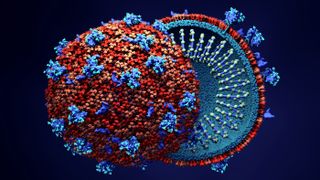Scientists figure out how new coronavirus breaks into human cells

(Image: © Shutterstock)
Scientists have revealed the first picture of how the new coronavirus SARS-CoV-2 binds with human respiratory cells in order to hijack them to produce more viruses.
Researchers led by Qiang Zhou, a research fellow at Westlake University in Hangzhou, China, have revealed how the new virus attaches to a receptor on respiratory cells called angiotensin-converting enzyme 2, or ACE2.
"They have pictures all the way down at the level of the atoms that interact at the binding interface," Thomas Gallagher, a virologist at Loyola University Chicago who was not involved in the new research but studies coronavirus structure, told Live Science. That level of information is unusual at this stage of a new virus outbreak, he said.
"The virus outbreak only began to occur a couple months ago, and within that short period of time, these authors have come up with information that I think traditionally takes much longer," Gallagher said.
That's important, he said, because understanding how the virus enters cells can contribute to research on drugs or even a vaccine for the virus.
ALL ABOUT CORONAVIRUS
A viral entryway
To infect a human host, viruses must be able to gain entry into individual human cells. They use these cells' machinery to produce copies of themselves, which then spill out and spread to new cells.
On Feb. 19 in the journal Science, a research team led by scientists at the University of Texas at Austin described the tiny molecular key on SARS-CoV-2 that gives the virus entry into the cell. This key is called a spike protein, or S-protein. Last week, Zhou and his team described the rest of the puzzle: the structure of the ACE2 receptor protein (which is on the surfaces of respiratory cells) and how it and the spike protein interact. The researchers published their findings in the journal Science on March 4.
"If we think of the human body as a house and 2019-nCoV [another name for SARS-CoV-2] as a robber, then ACE2 would be the doorknob of the house's door. Once the S-protein grabs it, the virus can enter the house," Liang Tao, a researcher at Westlake University who was not involved in the new study, said in a statement.
No comments:
Post a Comment